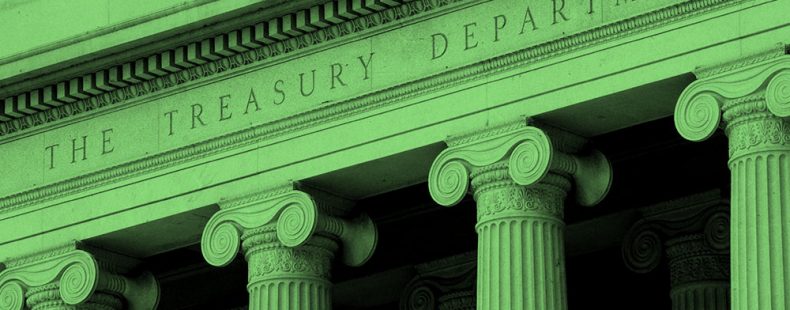In the United States, the debt ceiling is often a major source of heated debate among members of Congress. Often, the president also finds themself brought into the debt ceiling battle. If you don’t follow politics or economics too closely, you might be wondering what the heck the debt ceiling is. Is it really so important that Congress needs to fight about it seemingly every year?
The debt ceiling plays a central role in the government debt of the United States. Understanding government debt can be pretty tricky, as there are lots of words and terms thrown around when you are talking about huge amounts of money and debt. Words like default, discretionary spending, and appropriations are rich in dollars but often don’t make any sense to people who aren’t economics savvy. To help out, we tallied up a bill of some of the most commonly used words related to government debt and offered explanations free of charge.
revenue
Revenue is the income the government makes. The biggest source of a government’s revenue is typically taxes, but revenue can also be generated in other ways, such as from government-owned businesses or by selling bonds.
spending
Spending refers to the money the government spends. The government spends money on many different things, such as entitlement programs like Social Security, infrastructure, and the military. Entitlement programs are guaranteed benefits under federal law.
mandatory spending
Mandatory spending is spending that the government is required to do by law. For example, the US government is required to allocate money toward Social Security payments under the Social Security Act. According to government data, the majority of federal spending is mandatory spending.
discretionary spending
In the US government, discretionary spending refers to spending that is determined by the federal budget approved by Congress. Every year, Congress decides how spending is to be divided between the many programs and services the federal government is responsible for, such as the military and healthcare.
appropriations
The sums of money that government departments get from Congress are called appropriations. Every year, Congress passes appropriation bills that provide money to the specific departments that Congress has determined should receive money for particular projects and services. Many government programs and services depend on yearly appropriations to continue functioning.
debt
Debt is money owed by the government, which includes borrowing. In the simplest terms, government debt is the difference between revenue minus spending.
deficit
A deficit occurs when government spending is higher than revenue. The US government has had deficits for the last 20 years.
surplus
A surplus occurs when government revenue is higher than spending. The most recent US surplus occurred in 2001.
national debt
National debt, also known as sovereign debt, refers to money owed by a national government rather than by a local or state government.
public debt
Public debt is another term for national debt, but it is also used to refer to debt held by local and state governments. The term public debt is also often used to refer to the national debt owed to private citizens, investors, companies, state governments, and anyone else besides the national government itself.
intragovernmental debt
Intragovernmental debt refers to debt that the government owes itself. Specifically, this term is used to refer to when one government department owes money to another department in the same government. In the US, for example, the Social Security trust fund is paid for by bonds from the US Department of the Treasury.
default
A default is a failure by a government to pay the debts it owes. While countries do occasionally default, the United States never has. Due to the US’s major role in global economics, it is thought that a theoretical US default would cause a severe global economic crisis.
gross domestic product
Gross domestic product, or GDP, is the total value of all goods and services produced by a nation. Often, national debt is compared to a nation’s yearly GDP to determine how severe their debt actually is. For example, the US typically has both a yearly national debt and GDP totaling tens of trillions of dollars. If the US didn’t have such a high GDP, its debt would be an even greater issue than it currently is.
bond
A bond is a paper or certificate that states a government promises to repay a debt to an individual. Governments often raise money by selling bonds. A bond holder makes money by receiving interest payments, known as coupons or coupon payments, until the bond reaches the date when the government repays the initial value of the bond, which is known as the maturity date.
marketable and non-marketable securities
To raise money, the government sells both marketable and non-marketable securities, such as bonds. A marketable security can be sold to another person while a non-marketable security cannot. In the US, non-marketable securities are often tied to a specific person’s social security number.
credit rating
When discussing national governments, a credit rating is an evaluation of how likely a government is to pay back the debts that it owes. The credit ratings of national governments are determined by international credit rating agencies. Depending on the agency, the United States typically has the highest or second-highest possible credit rating.
full faith and credit
In economics, the phrase full faith and credit refers to an unconditional guarantee from one party to pay interest and debt to another party. The US Department of the Treasury issues bonds to investors and the public based on full faith and credit, which it has the power to do under the Constitution. Bonds and loans from the federal government are thus often considered to be risk-free (which encourages people to buy them) because the government can guarantee payment by raising taxes or printing more money.
debt ceiling
The debt ceiling, officially known as the debt limit, is the maximum amount of money that the United States government is allowed to borrow in a particular year. In theory, the debt ceiling exists to control borrowing. In practice, the federal government often raises the debt ceiling so that the government can borrow enough money to avoid default. The debt ceiling has been increased 78 times since 1960–often following intense debate by Congress.
brinkmanship
Brinkmanship is “the technique or practice of maneuvering a dangerous situation to the limits of tolerance or safety in order to secure the greatest advantage.” Neither American political party ever wants to see the US government default, so the debt ceiling debate is often a source of political battles. Both parties often accuse the other of using the debt ceiling as part of brinkmanship in order to force concessions under threat of allowing the US to default.
government shutdown
A government shutdown occurs when the government fails to fund itself through appropriations. During a government shutdown, only employees and services considered to be essential continue to operate. In the US, government shutdowns typically happen as a result of conflicts between the two major political parties.
recession
An economic recession is a period of low economic activity and growth. An especially severe or long recession is often referred to as a depression. Recessions and depressions often mean that GDP and tax revenue is low, which causes government debt to increase due to lower revenue.
What are the key differences between a recession and a depression? We break it down.
inflation
Inflation refers to a general increase in prices that causes money to lose its spending power. High inflation often leads to high interest rates. Because the government must pay interest on bonds it issues, high inflation and high interest rates can significantly increase the amount of national debt.
Take the debt terms quiz
After reading all these terms about government spending, we owe you a debt of gratitude. Check out our government debt terms word list to practice what you’ve learned. And once you think you’ve got a good grasp on these terms, try not to default on our government debt terms quiz.














